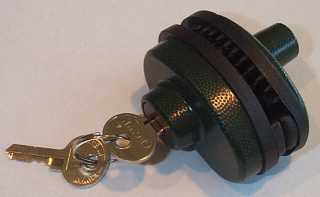
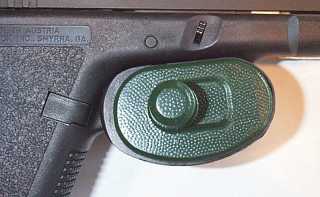
Let me systematically rip this so-called "safety" device apart.
THE LOCK
I purchased a trigger lock much as anyone would: go to a normal gun store and ask for a trigger lock. The one purchased was recommended and defended by a respectable gunstore owner. It is fairly heavy, seems solid, and has two fixed and six spring-loaded posts used to grab onto the trigger guard where possible.


At a first cursory glance, it looks decent enough for the job. That cursory glance is an ignorant glance, as we shall see.
BASIC GUN SAFETY RULES
First, let's review Cooper's Four Rules, as they are the ultimate in simple and complete safety:
TRIGGER LOCK INSTRUCTIONS
Here's what's on the back of the package of a trigger lock I bought:
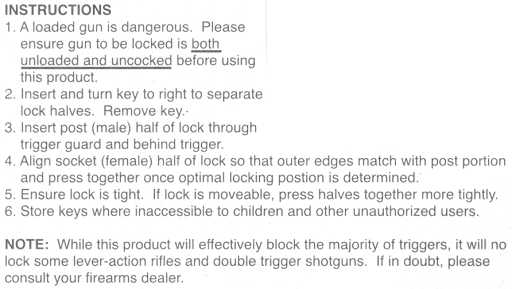
Let's pick those apart.
"1. A loaded gun is dangerous. Please ensure gun to be locked is both unloaded and uncocked before using this product."
We can all agree to the first sentence. I can't agree with the second. This first instruction violates Rule #1 as the device is designed for use on unloaded guns...but we MUST always treat guns as if loaded, even if known unloaded. While it is reasonable to unload/uncock a gun for storage, a product that requires it (beyond standard legal butt-covering) with such emphasis is suspect. Despite what the directions say, many people use trigger locks on loaded guns because they want to keep the weapon handy ("just a key-turn away!") but safe from the kids. A device that is so likely to be used in violation of its instructions is unsafe as it relies on people doing something other than what is "normal".
"2. Insert and turn key to right to separate lock halves. Remove key."
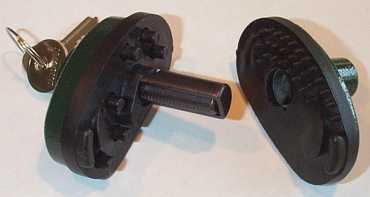
Fine.
"3. Insert post (male) half of lock through trigger guard and behind trigger."
Here the instructions violate Rule #3. Nothing should enter the trigger guard nor touch the trigger until you are ready to fire.
Let's look at a common firearm - a Glock 17 - and see how the trigger lock is used with it.
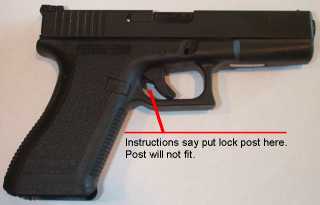
With the Glock 17; the trigger lock's post simply does not fit behind the trigger. Many (most?) people cannot be expected to follow directions and not use unsuitable devices, they just do what seems obvious. "Obvious" in this case is to insert the post in front of the trigger, where the lock fits very snugly onto the G17.
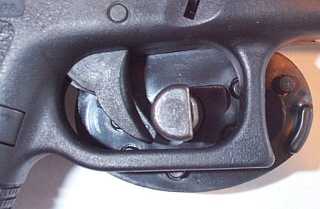
Unfortunately, not only is this post in front of the trigger, it actually touches the trigger and disengages the first (external) safety! In fact, with trivial movement, I can hear the second (first internal) safety disengage! Two of three safeties (as defined by Glock) are already disengaged, and I haven't even finished attaching the other half of the trigger lock yet. Should the gun have a more normal thumb-operated safety, the lock would do nothing to prevent someone from disengaging the safety separately.
One may argue that I violated this third instruction by placing the post in front of the trigger, and thus get what I deserve. Nonsense: if I hand this lock to a "normal, reasonable" person, with or without instructions (printed in small type on the back of the disposable cardboard packaging), the design of the lock will lead them to install it forward of the trigger.
"Behind trigger" they say. The lock does not fit behind the trigger of a Glock 17, Glock 26, Ruger Mk II, Daisy Power Line 1200, Mossberg 590, or Colt AR-15. It did fit (barely) on an SKS and Steyr Scout, but did so awkwardly, and the "natural" fit was in front of the trigger. In addition, instruction #1 (the "uncock weapon" part) will sometimes result in the trigger moving back, eliminating any existing space for the post. More on this behind-trigger problem later.
"4. Align socket (female) half of the lock so that outer edges match with post portion and press together once optimal locking position is determined."
Back to the Glock 17 case. The first time I "optimally locked" the device, a moderate rearward pressure on the lock resulted in the trigger triggering. Here's what happened (covering half removed to show detail):
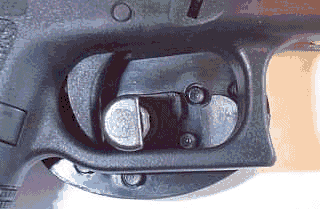
Had a round been chambered it would have discharged. Keep in mind that the lock does nothing to prevent someone from loading and chambering a round, even if the locked gun was indeed unloaded. Someone (say, a clever and curious child) could easily insert a magazine and chamber a round, then push on the lock and fire the gun. This device does not make a gun safe, it gives the illusion of safety.
I just did it again, this time significantly tightening the lock; it took some force but it "fired" again. You'd be surprised how much force a small child can create when fiddling with something; applying such force can easily require the barrel pointing at the unaware/ignorant fiddler.
"5. Ensure lock is tight. If lock is moveable, press halves together more tightly."
In the previous case, the lock was clearly "tight enough", but since the lock had already touched the trigger and disengaged two safeties, it didn't take much movement to fire the weapon.
Moving the lock to test tightness when there is already a post dangerously close to the wrong side of the trigger is a BAD IDEA as one must always assume the gun is loaded, and many people choose to use such a lock on a loaded gun.
Be aware also that a quality firearm may have a light trigger, meaning that very little force is needed to activate the trigger. Putting a metal post in front of and so close to such a light trigger and expecting it to not fire is dangerously negligent.
"6. Store keys where inaccessible to children and other unauthorized users."
Are the keys really inaccessable? Children are often curious, motivated, and out of sight of parent. They may find the keys.
"NOTE: While this product will effectively block the majority of triggers, it will no [sic] lock some lever-action rifles and double trigger shotguns. If in doubt, please consult your firearms dealer."
Well, I tried it on some significantly common and representative guns (Glocks, SKS, a Mossberg, AR-15) and it did not block the trigger according to the instructions, and the design persuades the user (who may or may not have or follow the instructions) to use the lock improperly.
I'll agree that there are some triggers that it clearly will not work on at all, but those are few and far between.
There. Of seven points of instruction, there seems to be problems with six of the points - not a good set of instructions. Other locks may have slightly different instructions, but the differences are just that: slight. Instructions that direct you to violate fundamental safety rules are unsafe.
OTHER POINTS
That was just the instructions. There's more problems.
As observed above, the design of trigger locks leads the user to improperly attach the device forward of the trigger. Since the instructions are not attached to the lock itself, people will tend to just "figure it out"...improperly.
A lock on a gun obviously impedes the ability to use the gun quickly. If an impending or in-progress assault occurs, one must locate the key, unlock the device, and (if one followed the directions) load and cock the weapon. One woman I met described her home's process that she concocted to give her time to unlock the gun before the attacker could get past the dog, a process akin to "please, Mr. Mugger, give me a moment to bring this weapon into service." A trigger lock on a defensive firearm is a recipie for a fatal disaster.
Even under ideal conditions a trigger lock can be a hinderance to proper and appropriate firearms use. Consider this news story: "Dennis Henigan of the Center to Prevent Handgun Violence drops the ball in front of a roomful of reporters, while trying to prove the efficacy of Saf-T-Lok, a purportedly easy-to-use combination lock in the gun's grip. Henigan fumbles and fails to unlock the gun in a well-lit room with no intruder at the door... Finally disengaging the safety, he apologizes, 'Most people aren't as klutzy as I am.'" While not the exact same device as examined in this article, this news story demonstrates the difficulty in unlocking a defensive firearm, even with preparation, practice, time and bright lights, when locked in a way contrary to truly proper preparation for a stressful and disorienting event.
Trigger locks (and other similar on-gun-only devices) do not prevent theft or meddling. A thief won't care if there's a lock, as he can quickly steal the locked weapon, and spend some quality time with a hacksaw later. Some children may also choose to spend similar "quality time" figuring out how to unlock the gun, find the keys, or otherwise make it fire. Only a safe bolted to the floor can prevent such removal or meddling.
There has recently been much talk of legislation requiring trigger locks. Such is yet another example of cocky ignorant people telling and forcing others to perform unsafe actions. All gun legislation (not just locks) should be fundamentally based on firearm safety as specified by those deeply familiar with such weapons. Eventually (or possibly already has happened) a trigger lock requirement law will persuade someone to use such an unsafe device and thru negligence/ignorance cause someone's death.
ALTERNATIVES
Safes: putting a gun in a locked & secured box is ideal and may be relatively inexpensive. Even if the gun is loaded, cocked and off-safe (as Rule #1 says you must always assume), a locked box completely prevents the gun from firing. A moderately more expensive box may even completely contain a discharge if (through some bizzare event) the gun should fire. A determined thief or child may find a way into a safe, but it is likely much more difficult than removing or abusing a trigger lock. Some safes have fast-access combination locks, which completely secure the weapon yet allow quick access under difficult conditions.
Cable locks: by passing a steel cable thru the magazine well and chamber, a cable lock prevents the insertion of a magazine, loading of a cartridge and the application of the firing pin. While it still permits easy theft and moderately easy removal (with hacksaw or bolt cutters), a cable lock does not inherently violate any safety rules.
Education: teaching a child how to behave around firearms, and permitting supervised use as early and often as possible, are the primary safety tool. If a child knows how to behave s/he can be safe around a loaded and unsupervised gun, while an ignorant child can too often access and misuse even a properly secured firearm. Eliminating the mystique of a gun by early and on-request supervised use does much to eliminate the motivating desire to secretly and dangerously play with a parent's gun.
Other entirely suitable security devices and methods exist. There is no reason to feel limited to using dangerous and deceptive trigger locks.
CONCLUSIONS
Cooper's Rules are designed such that if someone violates one rule, the other three will most likely prevent anyone from getting hurt. If two rules (fully half the rules) are violated, there is grave risk of death. Trigger locks violate rules #1 and #3. Instead of legislating for trigger locks, someone should be litigating against trigger locks as unsafe or defective products.
Some may argue that in fairness, a trigger lock still is better than not locking the gun at all (I'll admit that when applied, it was moderately hard to trigger the firing mechanism). That's essentially a naieve or trick argument. It's like saying that getting stabbed is better than getting shot: arguably true but profoundly missing the point. Anything that inherently violates the fundamental rules of safety, like trigger locks, is itself unsafe. When dealing with deadly weapons, such violations of safety must never be taken lightly or argued to be beneficial. With the cheap availability of cable locks, safes, and other inherently safe locking devices, there is no excuse to use trigger locks.
Other locking devices exist. When choosing one, make sure it does not violate any of Cooper's Four Rules. Trigger locks violate fully half the rules, and are easily shown unsafe by both reasoning and demonstration, even when used as designed. Trigger locks are simply deceptive and unsafe.